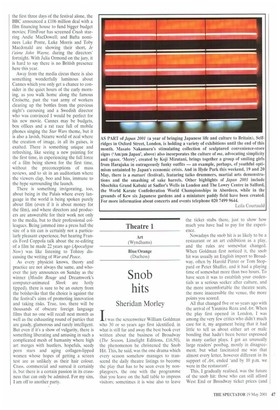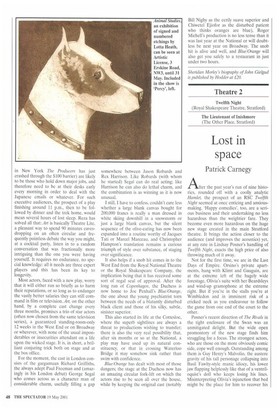Theatre 1
Art (Wyndhams) Blue/Orange (Duchess)
Snob hits
Sheridan Morley
It was the screenwriter William Goldman who 30 or so years ago first identified, in what is still far and away the best book ever written about the business of Broadway (The Season, Limelight Editions, £16.50), the phenomenon he christened the Snob Hit. This, he said, was the one drama which every season somehow manages to transcend the daily theatre listings to become the play that has to be seen even by nonplaygoers, the one with the programme that you leave on the hall table to impress visitors; sometimes it is wise also to leave
the ticket stubs there, just to show how much you have had to pay for the experience.
Nowadays the snob hit is as likely to be a restaurant or an art exhibition as a play, and the rules are somewhat changed. When Goldman first noticed it, the snob hit was usually an English import to Broadway, often by Harold Pinter or Tom Stoppard or Peter Shaffer. and it had a playing time of somewhat more than two hours. To have seen it was to establish your credentials as a serious seeker after culture, and the more uncomfortable the theatre seats, the more inaccessible the venue, the more points you scored.
All that changed five or so years ago with the arrival of Yasmina Reza and Art. When the play first opened in London, I was among the very few critics who didn't much care for it, my argument being that it had little to tell us about either art or male bonding that hadn't been better expressed in many earlier plays. I got an unusually large readers' postbag, mostly in disagreement, but what fascinated me was that almost every letter, however different in its support of Art, ended 'and by 10 p.m. we were in the restaurant'.
This. I gradually realised, was the future of the snob hit: those who can still afford West End or Broadway ticket prices (and in New York The Producers has just crashed through the $100 barrier) are likely to be those who hold down major jobs, and therefore need to be at their desks early every morning in order to deal with the Japanese emails or whatever. For such executive audiences, the prospect of a play finishing around 11 p.m., then to be followed by dinner and the trek home, would mean several hours of lost sleep. Reza has solved all that: Art is basically Theatre Lite, a pleasant way to spend 90 minutes eavesdropping on an often circular and frequently pointless debate the way you might, at a cocktail party, listen in to a random conversation that was fractionally more intriguing than the one you were having yourself. It requires no endurance, no special knowledge: all it needs are three expert players and this has been its key to longevity.
Most actors, faced with a new play, worry that it will either run so briefly as to harm their reputations, or so long as to endanger the vastly better salaries they can still command in film or television. Art, on the other hand, by a complete cast change every three months, promises a trio of star actors (often now chosen from the same television series), a guaranteed standing-room-only 12 weeks in the West End or on Broadway or wherever, with none of the usual imponderables or insecurities attendant on a life upon the wicked stage. It is, in short, a brilliant conjuring trick both on stage and at the box office.
For the moment, the cast in London consists of the gargantuan Richard Griffiths, the always adept Paul Freeman and (amazingly in his London debut) George Segal who comes across as a character man of considerable charm, usefully filling a gap somewhere between Jason Robards and Rex Harrison. Like Robards (with whom he started) Segal can do real acting; like Harrison he can also do lethal charm, and the combination is as winning as it is now unusual.
I still, I have to confess, couldn't care less whether a large blank canvas bought for 200,000 francs is really a man dressed in white skiing downhill in a snowstorm or just a large blank canvas, but the silent sequence of the olive-eating has now been expanded into a routine worthy of Jacques Tati or Marcel Marceau, and Christopher Hampton's translation remains a curious triumph of style over substance, of staging over significance.
It also helps if a snob hit comes in to the West End from the Royal National Theatre or the Royal Shakespeare Company, the implication being that it has received some sort of regal seal of approval. After the long run of Copenhagen. the Duchess is now home to Joe Penhall's Blue/Orange, the one about the young psychiatrist torn between the needs of a blatantly disturbed black client and those of his silky, subtle, sinister superior.
This also started its life at the Cottesioe, where the superb sightlines are always a threat to productions wishing to transfer; there is also the very real possibility that, after six months or so at the National, a play may have used up its natural constituency, or that in crossing Waterloo Bridge it may somehow sink rather than swim with confidence.
Blue/Orange has dealt with most of those dangers; the stage at the Duchess now has an amazing circular fork-lift on which the actors rise to be seen all over the house, while by keeping the original cast (notably Bill Nighy as the eerily suave superior and Chiwetel Ejiofor as the disturbed patient who thinks oranges are blue), Roger Michell's production is no less tense than it was last year at the National or will doubtless be next year on Broadway. The snob hit is alive and well, and Blue/Orange will also get you safely to a restaurant in just under two hours.
Sheridan Morley's biography of John Gielgud is published by Hodder at £20.



































































 Previous page
Previous page